The 2012 June 5-6 transit of Venus (ToV) is over, and there won't be another one till 2117! Many RASC members successfully viewed the ToV here and abroad, and you can find the graphic record of the observations―and of the astronomers making them―here.
Note: all images are copyright of the attributed photographers and graphic artists, and must not be used without prior permission
|
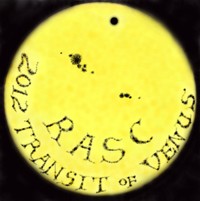 |
Dr. Vladimir Shiltsev, Director, Accelerator Physics Center, Fermilab

Fig. 1: Dollond’s 4.5 ft two-lens achromat Optical Tube Assembly, used by Alex Kukarin for the ToV2012 observations in CA
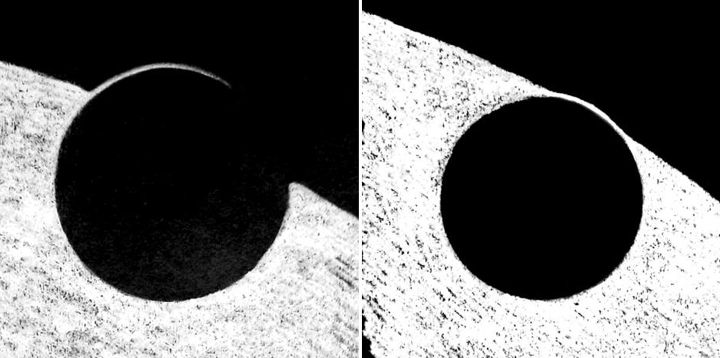
Fig. 2: Arc of light around Venus, and the light bulge on the edge of the Sun during ingress, as observed by Alex Kukarin in CA
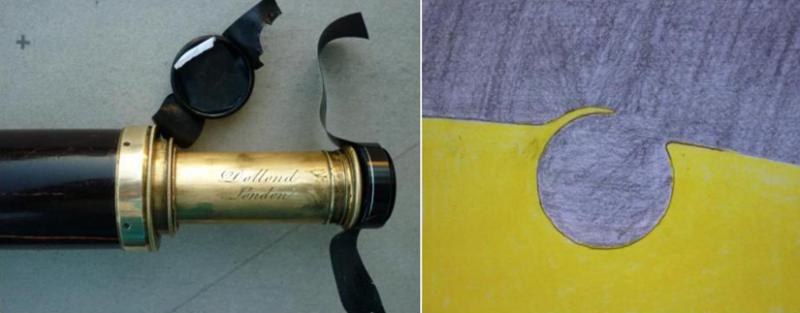
Figs.3-4: The 2.4 ft Dollond achromat refractor with two smoked glass filters, and a "whisker" observed with it in Batavia, IL
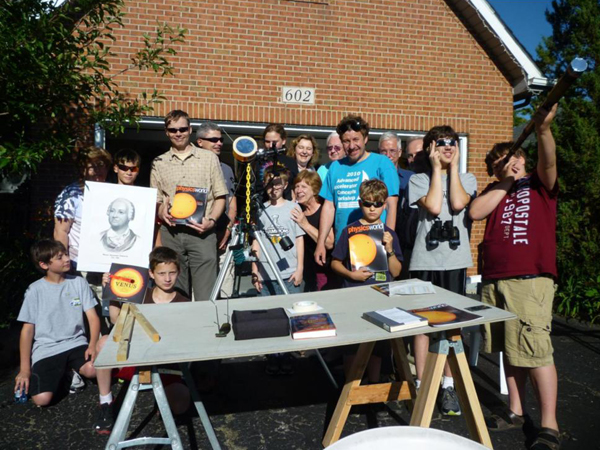
Fig.5: The ToV2012 observers in Batavia, IL - Mikhail Lomonosov was with us, too (see at the left)
Dr. Shiltsev writes:
This story began about a year ago when the world of science celebrated the 300th anniversary of Mikhail Vasilievich Lomonosov (1711-1765)—a great polymath, founder, and key figure of Russian science. Despite enormous fame in Russia, comparable to that of Ben Franklin in the US (e.g., even Russia’s leading Moscow State University is named after Lomonosov, it’s founder), Lomonosov is still curiously unsung in the West, as indicated in an excellent article “Mikhail Who?” by Robert Crease in the Nov.11 issue of Physics World magazine. The general public got an opportunity to learn about this outstanding Russian genius in a series of publications, such as my article in the Feb. 2012 issue of Physics Today. Discovery of the atmosphere of Venus during its transit over the Sun’s disc in 1761 is one of the most remarkable of his numerous scientific achievements. Observation of a "pupyr"—the Russian term for a blister/bulge/arc of light around the part of Venus off the Sun’s disc early at the egress—was one of the keys which allowed him to conclude that: "…the planet Venus is surrounded by a significant air atmosphere similar to (if not even greater than) that which surrounds our terrestrial globe". Lomonosov published his report in Russian and in German, giving the most detailed description of the aureole effect, and a complete and correct physical explanation of the phenomena as refraction of the solar rays in the atmosphere of Venus, being accorded priority for this important observation (see the English translation at https://arxiv.org/abs/1206.3489). Many astronomers in 1769, 1874 and 1882 extended his work by seeing the Lomonosov arc in finer detail.
When the transit of Venus (ToV) 2012 was approaching a controversy erupted over whether Lomonosov could have seen the arc at all—critics questioned his discovery, citing their experience during the ToV2004 when they had difficulties seeing such a subtle phenomenon even with instruments which were supposedly far superior to the telescopes employed in the 18th century.
So, to put the doubts to an end, it seemed a very attractive proposition to attempt to reconstruct Lomonosov’s observations. This would require access to a telescope like Lomonosov’s, careful reproduction of his techniques, and, of course, good weather on June 5th, 2012. At the time I started to contemplate this exercise in experimental archaeology of astronomy, all there was to go on was the information in Lomonosov’s report, that he used a 4.5 ft long refractor, with a two-lens objective, employed with a very weak filter (“not-so-heavily smoked glass”), and that he regularly rested his eyes to improve their sensitivity and reduce observer fatigue. I had but three indirect indications that Lomonosov most probably used one of the early two-lens achromat refractors built by John & Peter Dollond in the UK (their operations began in 1758). I thought it would be prudent to discover more about the optical system Lomonosov might have used, and to secure access to such an antique instrument. Timely help arrived from Yuri Petrunin—a prominent telescope historian, expert in the manufacture of the finest hand-made refractors, and, incidentally, the President of the Telescope Engineering Company (TEC) in Colorado (USA). Not only had Yuri found solid direct evidence regarding Lomonosov’s refractor (the original was a casualty of war and fire during the siege of St. Petersburg, when the legendary Pulkovo Observatory was virtually leveled by enemy action), but he happened to own a similar instrument with an impeccable provenance! This fine, high quality instrument was lent to the most experienced observer in our team—Alex Kukarin. Alex’s observing station was at the historic Lick Observatory. Alex employed a ND M3.8 filter (a relatively weak filter by modern standards, with an attenuation of about 1/6,000), and just as importantly, he followed Lomonosov’s example by keeping his eyes rested, to ensure their maximum sensitivity. Yuri Petrunin himself readied another 18th-century Dollond achromat for his own use in a ToV station in Colorado. And I bought a 2.4 ft Dollond two–lens achromat, and prepared a purpose made weakly-smoked glass solar filter which was at the limit of tolerance for my eyes when observing the Sun through the OTA (later, its attenuation was measured to be about 1/1,700 in visible light—WARNING: for safety reasons I do not recommend that anyone use such a light filter! Do not try this at home!). The fourth member of our team—Igor Nesterenko—was set to observe the ToV2012 in Novosobirsk, Rusia, with a 600mm long "C.West, London" refractor dating from the early 19th century, equipped with a ND M3.8 filter. From transitofvenus.nl I learned that Randall Rosenfeld was attempting to organize transit observations with old scopes as well, and we stayed in touch.
Finally, when the day had come—zero hour for the transit!—we were able to fully and undoubtedly confirm Lomonosov’s observations! Alex observed a light “whisker” of light off the Sun’s disc over Venus at mid-ingress, and a full arc later at the ingress. I too saw a very long, bright whisker over the disc of Venus, at ingress, For more details of the experiments see our draft reports.We were both struck by the very impressive quality of the images delivered by the antique refractors!
Of course, as is typical for transit campaigns, success was not the only story of the day—Yuri and Igor had no luck due to weather and atmospheric conditions in Colorado and Russia. Alex reported a funny incident; in his specially prepared outfit (see Fig.5 in his report), he looked like a robber with a black hood, and while he was preparing for the transit, a curious pedestrian spotted him, and wanted to find out what was going on, and whether any help was needed. When Alex stood up and turned to face him, the curious pedestrian became a scared pedestrian, and quickly took to his heels. As for me, on the block of my neighborhood in Batavia, IL (USA) June the 5th was the biggest event on the block. Over 50 people—more than half of them kids—came by, and experienced the black disc of Venus traverse the Sun through the six instruments prepared for the event. Besides the Dollond, I had another 4ft refractor from the 19th century, two modern Newtonian reflectors (900 and 500 mm long), binoculars, and solar eclipse glasses. Of course, instruments meant for the general public were equipped with very safe Baader ND M5.0 full aperture filters.
That was a remarkable day for thousands of astronomers worldwide. In Russia, even though many observers faced disappointment due to the weather, more than 20 observers reported seeing Lomonosov’s arc at ingress or/and at egress, using a broad variety of modern instruments. One of them, sharing his excitement on the all-Russian astroforum astronomy.ru even suggested a toast: “Za pupyr’!” (For the blister!)”. I would like to join him, and toast everyone who had luck observing Lomonosov’s arc around Venus on June 5-6, 2012!
Dr. David Levy, Jarnac
|
Wendee and I had a small transit party here at Jarnac Observatory, with Eli and Dalia Maor (Eli is the author of Venus in Transit), John and Liz Kalas, Ellen Finney, Robert Crawford, Twila Peck, and Tim and Carol Hunter. We enjoyed the tarnsit from 3:09 p.m. to sunset at 7:35. It was very hot, but otherwise perfect. Enclosed are three pictures, one showing the transit just after second contact, a second near the middle, and sunset. I hope you can use these!
|
Dr. William Sheehan, RASC Honorary Member
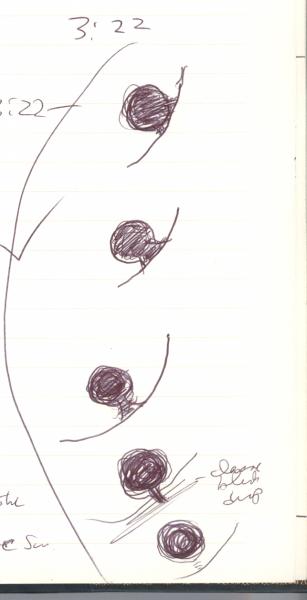 |
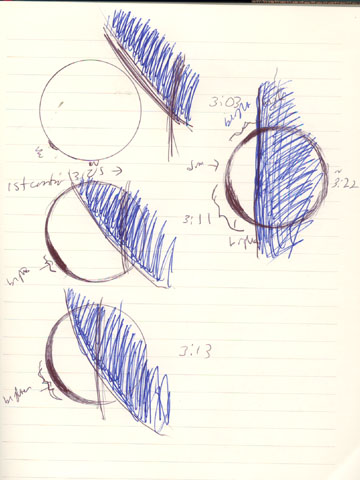 |
 |
|
|
I was at Lowell Observatory for three weeks, and was joined on the Sunday before the transit by Paolo Tanga who had two coronagraphs as part of the international twilight arc project developed at the Paris and Nice Observatories. Paolo used one for CCD imaging, and I used the other visually. The results were very successful for us in Flagstaff, despite high winds.
I had great views of the aureole’s development and also, somewhat surprisingly, had a very elaborate black drop, which started as a kind of nimbus-like black platform and eventually resembled taffy stretched into a ligament that dissolved rather than broke. These will be published. What is most interesting however is that I did continue to see the arc even when the black drop was evident, so I do think it likely that Lomonosov saw something similar.
The other thing that makes the intensive observation of the transit of Venus of importance is that it will provide an archive of data involving phenomena such as the aureole, and the black drop, and limb darkening of the Sun that may allow calibration of exoplanet observations of hot planets with substantial atmospheres.
I was pleasantly surprised that the interest in the transit of Venus this year—probably because of the poignancy of its being the swansong event of our lifetimes—generating much more public interest than that in 2004.
|
|||
Luca Vanzella, Edmonton Centre
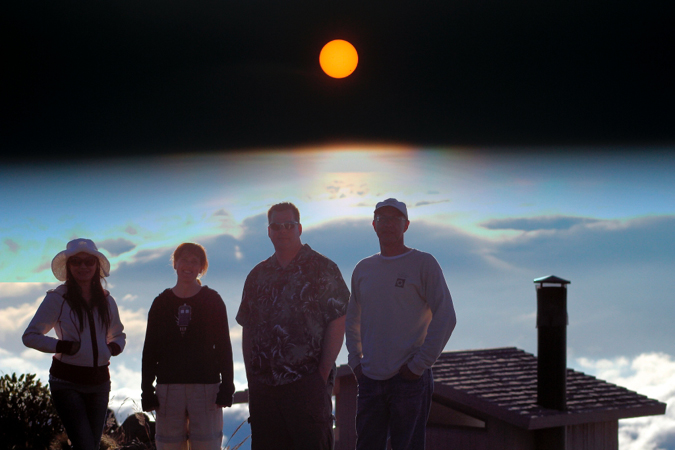
Luca writes:
I had decided a long time ago that my second and last Transit of Venus would need virtually guaranteed clear skies, so there was really only one choice—Hawaii. Since Maui is "no ka oi" (best), the 10,000 ft summit of Haleakala (House of the Sun) was the place to be.
The transit day forecast for the summit was windy, and crowded. "Windy" would make for shaky views, while "crowded" meant that access to Science City had been capped to a named list. A trusted local amateur astronomer advised me to consider Kalahaku Overlook, which offered some advantages. While not at the very summit, the overlook at 9300 ft would still be above the normal cloud deck, and the lava outcrops would provide some wind relief. Access to the overlook was not going to be controlled, and the entire transit would be visible. I was also advised to get up there early, as who knew how many people would invade the mountain that day. It was with this sage advice, that Krista Stefan and I (RASC Edmonton Centre) headed up the mountain at 08:30, almost 4 hours before first contact, with only a 2 hour drive ahead of us. Jay Lavender and Daisy followed us up the mountain about an hour later. My wife Kathryn decided to try her luck on the shores of Maui, chasing holes in the clouds and looking for shelter from the wind (the island had been under an unusual breezy spell for some weeks).
When we drove through the cloud deck, we came upon a beautiful blue sky that would stay that way for the whole transit, with 50km visibility. The overlook had very few people on it, so we had our pick of locations. We chose a spot above the parking stalls and beside a lava wind shield, that would accommodate our little group and gear. Krista set up her Celestron First Scope, while I deployed my trusty Megrez 80mm refractor and some camera gear. Jay set up his Lunt 60mm H-Alpha scope.
The wind was not a big issue most of the time, but did kick up a bit just as C1 approached. Krista and I observed while Jay recorded the entire ingress in HD video. I was a bit late on my C1 timing—not sure why because I knew where to look based on the sunspot positions. Jnani Cevvel and I had planned to calculate the Astronomical Unit, combining my timings with his from Yellowknife NWT, almost 5600 km distant, so I thought this might affect it. As it turned out, he didn't see C3 due to clouds, so he provided an estimate. Our timings obtained a value of 177 million km—not very close but it was fun trying it.
The drops at C2 and C3 weren't so black as much as they were a grey schmutz between Venus and the Sun's edge.
During the middle part of the transit, we observed in both white and H-alpha light, the latter having a distinct 3D look to it, with Venus definitely looking like it was nearer to Earth than the Sun. I don't recall this from the 2004 transit, perhaps having more sunspots this time made a difference.
A few other people were at the overlook specifically for the transit, but most people were the usual day-trippers coming upcountry to sightsee and hike. Many stopped for a look and several Galileo moments ensued.
Down at sea level, Kathryn chased holes in the clouds and fought the breezes that shook her projection viewing setup with a Galileoscope. She observed many parts of the transit at different locations, including a strip mall parking lot, where several appreciative workers stopped by to have a look, this possibly being their only opportunity to see it.
Back up on Haleakala, just like during an eclipse, the time passed quickly as we observed, shared views, photographed, sketched and timed contacts. As the afternoon wore on, the winds calmed down. The sun was quite low for C4, and its edge was roiling making the timing of the last contact harder. Jay once again recorded the entire egress in HD video.
Our day ended with some magic hour photography, a very nice sunset, and the triangular shadow of Haleakala reaching out to the apropos belt of Venus.
Dr. Ralph Chou, Toronto Centre
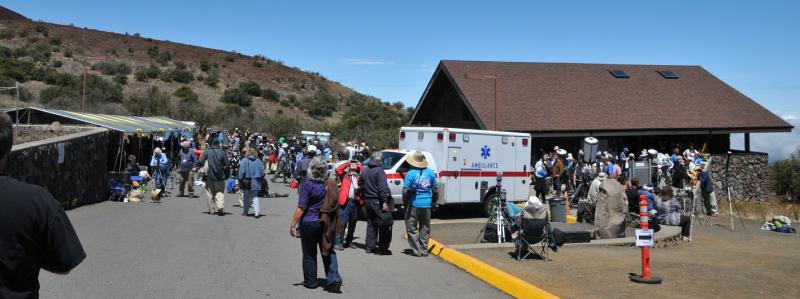
images by Scott Masterton
Dr. Chou writes:
Our party of 11 set out on Sunday, 3 June at just after 11:00 a.m. EDT and arrived at our hotel in Hilo on the Big Island at just before 9:00 p.m. Hawaiian time. We should have been 12, but one of our travelers injured herself late last week and was unable to fly. Luckily she had trip cancellation insurance. As for the rest of us, not having slept on the planes, We were all very tired by the time we checked in, not having slept on the planes.
Monday was spent playing tourist, visiting the Rainbow Falls in Hilo, and checking out the Volcanoes National Park. We visited the usual currency extraction sites, Big Island Candies and Hilo Coffee Mill, where we sampled macadamia nut confections and cookies, and Hawaiian coffee... While Hilo was its usual, rainy self, the clouds and mist lifted while we were at Kilauea so that we could see the activity in the central crater in the caldera. It was an impressive sight. Once we returned to the hotel, it was time to check out equipment for the big event next day. Logging on to the internet, it was somewhat disturbing to see the weather forecast for Mauna Kea the next day: at the summit 0 to 20% cloud cover with high winds, temperatures near freezing and 50% chance of fog. Oh, oh...
My email inboxes had about 200 new messages received since Sunday morning, with quite a few last –minute requests for information on safe solar viewers and filters for cameras and telescopes. At the end of April, I spoke at the Transit of Venus Symposium held at the University of Toronto, and my talk along with presentations of the other speakers had been posted on Youtube by the University of Toronto Scientific Instruments Collection, the organizers of the symposium. I suppose many of the inquirers had seen the Youtube video, since it garnered nearly 40,000 hits by this weekend. Being "on the road" made it difficult to respond to all of the inquiries, although I tried my best to do so before heading off to bed.
We were picked up at our hotel at 9:00 a.m. Tuesday morning by drivers Wendell and Steven with 4-wheel drive vans to carry us to the Visitor Center. We loaded our stuff aboard the vans and headed for Mauna Kea. Although it was cloudy over Hilo, as we drove up the Saddle Road, the clouds began to lift, and before long we could see clear blue sky over both Mauna Kea and Mauna Loa. Reaching the Visitor Center, our drivers were directed to park in the nearly full parking lot where we unloaded our equipment. The grounds were teeming with both casual and serious observers. Lo and behold, Guy Nason and I met up with Dave McCarter of the RASC London Centre and his wife, who had set up a small refractor with solar filter, and were there as volunteers with the day's outreach program. We had a nice chat about what was going on at the site. We also met national VP Glenn Hawley. Several members of the group were a bit unsteady on their feet due to the altitude.
We successfully observed the beginning of the transit, although the contact times we recorded weren't very precise. We broke for lunch, and met with Joy Pollard, the Gemini North outreach officer, who conducted a safety briefing. The nine who were going to the summit went to catch the shuttle bus to the summit, getting the news that not only was it clear at the summit, but that there was a steady breeze and a temperature of about 40°F – not bad. Nobody was allowed on the summit without warm clothing. Needless to say, lots of visitors in shorts and T-shirts were turned away. You have to wonder, what were they thinking? Did they really expect it would be balmy up there? Much of the 8 mile ride was over a very bumpy dusty road that really stimulates the bladder ...fortunately the last couple of miles were smooth pavement.
Alighting from the bus on the summit, one rapidly realizes that it isn't easy getting used to the altitude. That last few hundred meters walking uphill from the bus stop to the Gemini North was a real struggle not only due to the cold wind, but also the pounding heart and the lack of breath. Once inside the reception hall, Joy tested our blood oxygen, and 3 of us, including yours truly, got oxygen bottles since we were dangerously low. That helped a lot.
The tour of the facility went without a hitch. That is one humungous telescope! It has a mirror 8.1 meters in diameter and only about 30 cm thick. Active optics actuators help to maintain the mirror's shape as gravity distorts it in the various directions the telescope is pointed, while adaptive optics is used on the secondary to eliminate scintillation due to the air currents above the telescope . The control room looks like the bridge of a starship on Star Trek with a bank of monitors relaying all sorts of information about the state of the telescope, the object it is pointed at, and the weather conditions outside.
Before leaving the observatory, Joy tested everybody's blood oxygen levels, and the three of us seemed to be in immediate trouble as soon as the oxygen masks were taken off. She decided to take us down to HP in her vehicle as a medical emergency, while the others took the shuttle bus. We started down the mountain, and by the time we got to the second last switchback, we were already feeling much better. However Mauna Kea had one more ace up its sleeve – the tire pressure sensor turned on as we entered the penultimate curve. This was not good news. Joy pressed on and got us to Hale Poaku (the observers' residence, commonly called HP by observatory staff), where we found the right front tire nearly deflated. Talk about luck and skillful driving. We thanked her for her help, collected our equipment from the HP dining room, and set up to observe the last of the transit.
The sun disappeared behind the cinder cones to the west of HP before we could see 3rd contact, but we were able to image the transit until about 6:19 p.m. Guy, with Joan Masterton's help, moved his PST several times to take advantage of a gap between the cinder cones to extend our viewing time. Then it was time to break the equipment down, pile back in the vans and head back to Hilo, where it was raining yet again.
On the internet after dinner for the first time on Tuesday, there were requests for information as late as an hour before the transit started! Talk about procrastination! I was happy to read that many of our friends at home in the GTA, and across much of North America were able to see at least some of the transit. Congratulations and thanks to everyone who came to the OSC, DDO, York University and Varsity Stadium to help out on Tuesday. You really represented the best of the Toronto Centre to the public. Congratulations also to the crew at the CAO – I only wish our group in Hawaii could have had some of Lora Chow's transit cake!
So the 2012 transit of Venus trip is almost over, and we can notch another success.
Tim Cole, Ottawa Centre
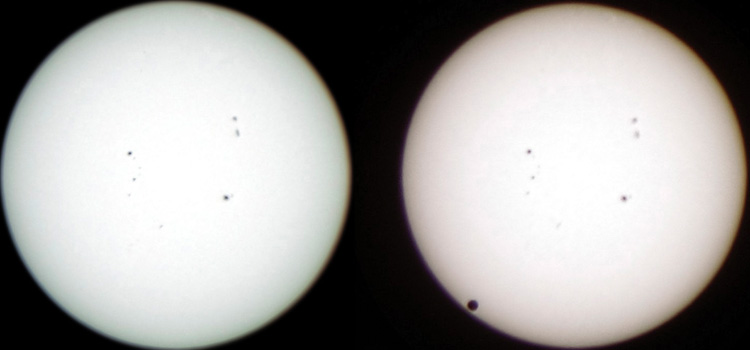
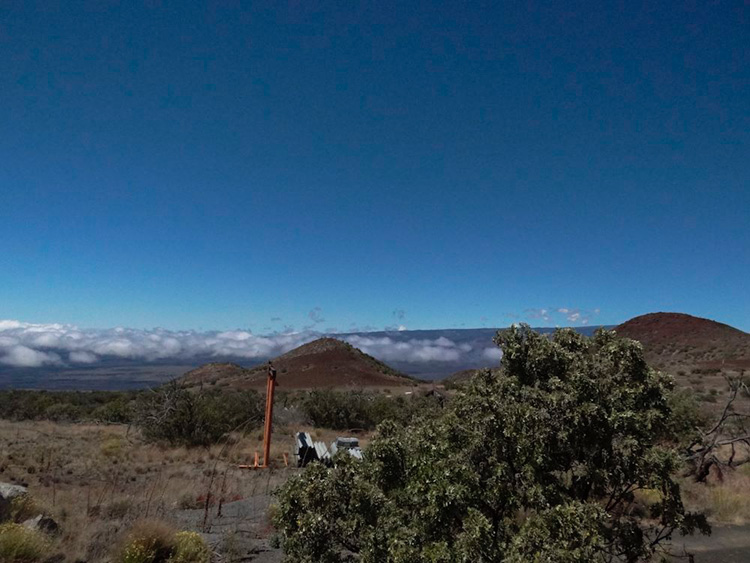
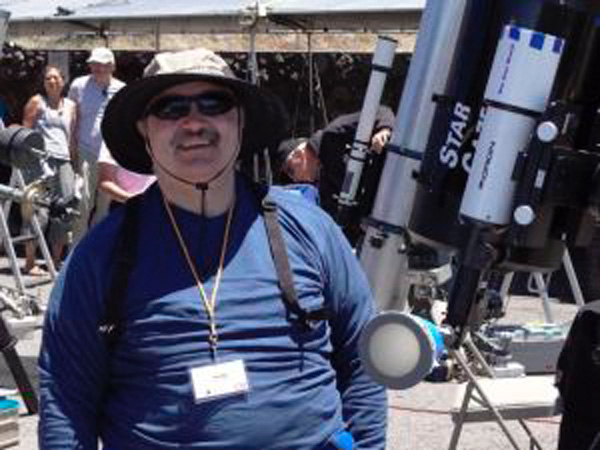
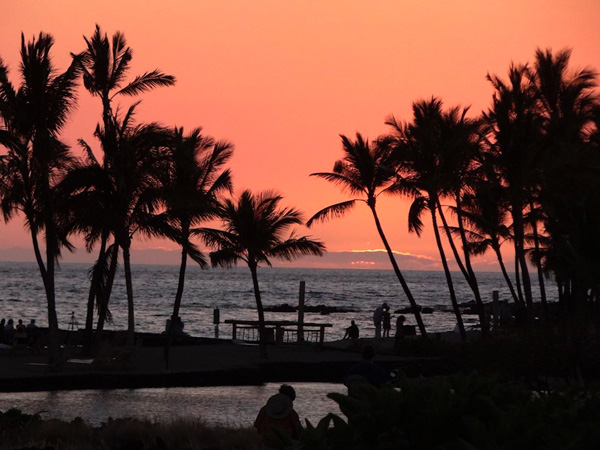

Tim writes:
Oddly enough for me, I was up at dawn that morning. As I’d posted that morning, the weather seemed to be cooperating. Certainly the view from my hotel balcony was encouraging.
Our Sky and Telescope Transit of Venus group traveled to the Visitor Information Station (the “VIS”) on Mauna Kea in nine separate vans. By 10:30 my van arrived at the VIS. Parking was already becoming a problem, but our group’s “headquarters” area was outside the staff residence complex for the observatories. That’s just a short distance uphill from the VIS, so there was plenty of time to find a spot and set up.
The VIS is 9200 feet above sea level. At that altitude, the air pressure is about 73% of its sea level value. Getting out of the van, just walking took more effort than I’d imagined, even though I’d known what to expect. Some things have to be experienced — thinking it through just doesn’t quite do it.
Preparation does help, though. I’d been advised to walk slowly and to pay attention to breathing deeply. It worked well, and I soon found that I hardly noticed the thinner air. Most of the time, anyway. Walking uphill from the VIS reminded me where I was. Pride cometh before the gasping wheeze!
By noon, most people I could see were either peering through their own telescopes or binoculars, or clustered around the public telescopes with projection viewers. There was a strong, somewhat gusty wind that jostled my telescope, but the Sun’s image was crisp, with a sharp limb and vivid sunspots.
Observers using hydrogen-α filters could see Venus move in front of the Sun’s chromosphere, invisible to white-light observers like me. It gave us a bit of advance notice of First Contact — about half a minute, as it turned out.
My first view of the 2012 Venus Transit was a tiny notch in the Sun’s limb. Over the next dozen minutes, I watched as Venus slowly moved into the Sun’s disc. When Venus was perhaps 80% of the way across the Sun’s limb, I saw a faint grey edge around the “space side” of Venus. It wavered, and didn’t form a complete circular arc, but I’m certain I saw the famous aureole of Venus.
Just before Second Contact, I looked carefully for infamous black drop effect. I didn’t see anything like the threads and tear-drops described in journals from the 1761 and 1769 expeditions, but I noticed some faint blurring of the trailing edge of Venus as it moved across the limb. Judging by comments from nearby observers, most of us saw only mild versions of the black drop effect.
By 12:30, Venus had completely crossed the limb, and I got a few photos for keepsakes. This was a great time to wander around the observing area, look at projected images of the Sun and Venus, take a few peeks through other ‘scopes, and generally share the experience with other astronomers. For the next few hours, I took the opportunity to mingle, see terrestrial sights, and take frequent peeks at Venus crossing the Sun.
More of Tim's transit images are avaialble, and you might enjoy his astronomy blog.
- Log in to post comments
